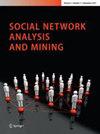Reactions to science communication: discovering social network topics using word embeddings and semantic knowledge
IF 2.3
Q3 COMPUTER SCIENCE, INFORMATION SYSTEMS
引用次数: 0
Abstract
Abstract Social media platforms that disseminate scientific information to the public during the COVID-19 pandemic highlighted the importance of the topic of scientific communication. Content creators in the field, as well as researchers who study the impact of scientific information online, are interested in how people react to these information resources. This study aims to devise a framework that can sift through large social media datasets and find specific feedback to content delivery, enabling scientific content creators to gain insights into how the public perceives scientific information, and how their behavior toward science communication (e.g., through videos or texts) is related to their information-seeking behavior. To collect public reactions to scientific information, the study focused on Twitter users who are doctors, researchers, science communicators, or representatives of research institutes, and processed their replies for two years from the start of the pandemic. The study aimed in developing a solution powered by topic modeling enhanced by manual validation and other machine learning techniques, such as word embeddings, that is capable of filtering massive social media datasets in search of documents related to reactions to scientific communication. The architecture developed in this paper can be replicated for finding any documents related to niche topics in social media data.对科学传播的反应:利用词嵌入和语义知识发现社会网络主题
2019冠状病毒病大流行期间,向公众传播科学信息的社交媒体平台凸显了科学传播话题的重要性。该领域的内容创造者,以及研究在线科学信息影响的研究人员,都对人们对这些信息资源的反应感兴趣。本研究旨在设计一个框架,该框架可以筛选大型社交媒体数据集并找到对内容交付的具体反馈,使科学内容创作者能够深入了解公众如何感知科学信息,以及他们对科学传播(例如,通过视频或文本)的行为如何与其信息寻求行为相关。为了收集公众对科学信息的反应,该研究将重点放在医生、研究人员、科学传播者或研究机构代表的推特用户上,并从大流行开始的两年内处理了他们的回复。该研究旨在开发一种解决方案,该解决方案由人工验证和其他机器学习技术(如词嵌入)增强的主题建模提供支持,能够过滤大量社交媒体数据集,以搜索与科学传播反应相关的文档。本文中开发的架构可以复制用于查找与社交媒体数据中特定主题相关的任何文档。
本文章由计算机程序翻译,如有差异,请以英文原文为准。
求助全文
约1分钟内获得全文
求助全文
来源期刊

Social Network Analysis and Mining
COMPUTER SCIENCE, INFORMATION SYSTEMS-
CiteScore
5.70
自引率
14.30%
发文量
141
期刊介绍:
Social Network Analysis and Mining (SNAM) is a multidisciplinary journal serving researchers and practitioners in academia and industry. It is the main venue for a wide range of researchers and readers from computer science, network science, social sciences, mathematical sciences, medical and biological sciences, financial, management and political sciences. We solicit experimental and theoretical work on social network analysis and mining using a wide range of techniques from social sciences, mathematics, statistics, physics, network science and computer science. The main areas covered by SNAM include: (1) data mining advances on the discovery and analysis of communities, personalization for solitary activities (e.g. search) and social activities (e.g. discovery of potential friends), the analysis of user behavior in open forums (e.g. conventional sites, blogs and forums) and in commercial platforms (e.g. e-auctions), and the associated security and privacy-preservation challenges; (2) social network modeling, construction of scalable and customizable social network infrastructure, identification and discovery of complex, dynamics, growth, and evolution patterns using machine learning and data mining approaches or multi-agent based simulation; (3) social network analysis and mining for open source intelligence and homeland security. Papers should elaborate on data mining and machine learning or related methods, issues associated to data preparation and pattern interpretation, both for conventional data (usage logs, query logs, document collections) and for multimedia data (pictures and their annotations, multi-channel usage data). Topics include but are not limited to: Applications of social network in business engineering, scientific and medical domains, homeland security, terrorism and criminology, fraud detection, public sector, politics, and case studies.
 求助内容:
求助内容: 应助结果提醒方式:
应助结果提醒方式:


